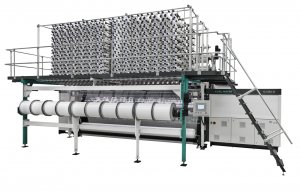Exceptional fabric appearance with unrivalled filigree pattern
Warp Knitting/Crochet
Karl Mayer optimises creel feed for lace machines
Modern lace machines, such as Karl Mayer’s JL 59/1 and JL 42/1, operate at extremely high speeds and offer a level of efficiency that has never before been achieved, but they also place new demands on the logistics of yarn processing. Karl Mayer therefore optimised its transverse draw-off creel earlier this year to enable it to meet the increased demands made on yarn delivery. The use of transverse creels is a concession to high machine speeds, since the proble
26th October 2010
Knitting Industry
|
Obertshausen
Modern lace machines, such as Karl Mayer’s JL 59/1 and JL 42/1, operate at extremely high speeds and offer a level of efficiency that has never before been achieved, but they also place new demands on the logistics of yarn processing.
Karl Mayer therefore optimised its transverse draw-off creel earlier this year to enable it to meet the increased demands made on yarn delivery. The use of transverse creels is a concession to high machine speeds, since the problem-free processing of pattern beams at maximum speed cannot currently be guaranteed.
The original version of the transverse draw-off creel for delivering yarns to the machine carried a maximum of 288 bobbins in 12 tiers and 24 rows. Karl Mayer says the arrangement of the bobbins resulted in a compact design and provided just enough space for changing the bobbins.
To ensure that the components used for yarn tension control are not in the way, the original circular arrangement of the ballooning limiter was reduced, a compromise between the requirements of the space available and the operating reliability. As a function of the yarn elasticity, the pattern and the machine speed, the yarn can start to jump, resulting in machine stoppages.
According to Karl Mayer, its new creel design now enables the yarns to be delivered more reliably. This optimised arrangement provides space for 20 bobbins in the horizontal direction and 18 in the vertical direction, i.e. a total of 360 bobbins, and the height is virtually the same as that of the original version.
To reduce the amount of space, the creel has been equipped to handle the normal bobbin dimensions used in the lace industry, i.e. a diameter of 135 mm and a length of 250 mm.
The wound bobbins are also positioned in rows in a staggered arrangement. This means that every second position in every row is unoccupied. This produces a specific loading configuration with six packages arranged around a circular, generously dimensioned doffing area. To ensure that this is easily accessible for changing the yarn the yarn tensioning elements are now located on short struts instead of on continuous rails.
Karl Mayer says that the space gained by this optimised arrangement of bobbins not only simplifies handling but also enables circular ballooning limiters to be used, an important contribution to increasing the processing efficiency and thus the operating reliability.
Increasing the creel to 18 tiers also takes into account the trend towards having more string bars on lace machines. One string bar is normally allocated to each creel line. The 18 x 20 bobbin arrangement corresponds to the normal repeat widths, and is said to save space and reduce machine peripherals. Karl Mayer says that the speed potential of the machine can now be utilised even more effectively and yarn handling is simplified considerably – an all-round solution for improving productivity.

Business intelligence for the fibre, textiles and apparel industries: technologies, innovations, markets, investments, trade policy, sourcing, strategy...
Find out more















